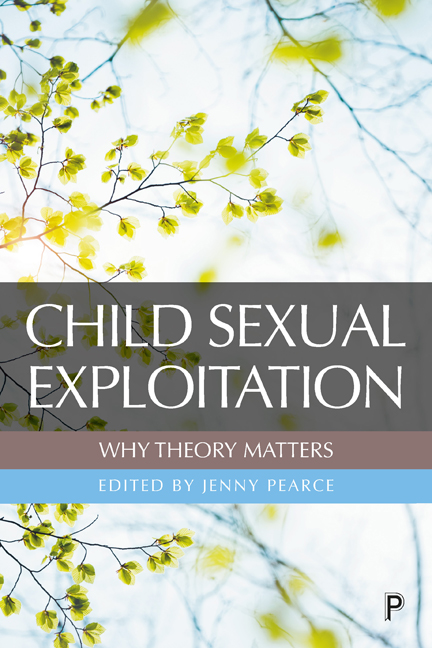Book contents
- Frontmatter
- Contents
- List of Figures and Tables
- Notes on Contributors
- Editor’s Acknowledgements
- Foreword
- 1 Bringing Theory Home: Thinking About Child Sexual Exploitation
- 2 Moving Beyond Discourses of Agency, Gain and Blame: Reconceptualising Young People’S Experiences of Sexual Exploitation
- 3 Child Sexual Exploitation, Discourse Analysis and why we Still Need to Talk About Prostitution
- 4 Contextual Safeguarding: Theorising the Contexts of Child Protection and Peer Abuse
- 5 ‘Losing Track of Morality’: Understanding Online Forces and Dynamics Conducive to Child Sexual Exploitation
- 6 Understanding Adolescent Development in the Context of Child Sexual Exploitation
- 7 Some Psychodynamic Understandings of Child Sexual Exploitation
- 8 Understanding Trauma and its Relevance to Child Sexual Exploitation
- 9 Social Support, Empathy and Ecology: A Theoretical Underpinning for Working with Young People who have Suffered Child Sexual Abuse or Exploitation
- 10 Using an Intersectional Lens to Examine the Child Sexual Exploitation of Black Adolescents
- 11 What’s Gender Got to do With It? Sexual Exploitation of Children as Patriarchal Violence
- 12 Understanding Models of Disability to Improve Responses to Children with Learning Disabilities
- 13 Some Concluding Thoughts
- Index
6 - Understanding Adolescent Development in the Context of Child Sexual Exploitation
Published online by Cambridge University Press: 10 March 2021
- Frontmatter
- Contents
- List of Figures and Tables
- Notes on Contributors
- Editor’s Acknowledgements
- Foreword
- 1 Bringing Theory Home: Thinking About Child Sexual Exploitation
- 2 Moving Beyond Discourses of Agency, Gain and Blame: Reconceptualising Young People’S Experiences of Sexual Exploitation
- 3 Child Sexual Exploitation, Discourse Analysis and why we Still Need to Talk About Prostitution
- 4 Contextual Safeguarding: Theorising the Contexts of Child Protection and Peer Abuse
- 5 ‘Losing Track of Morality’: Understanding Online Forces and Dynamics Conducive to Child Sexual Exploitation
- 6 Understanding Adolescent Development in the Context of Child Sexual Exploitation
- 7 Some Psychodynamic Understandings of Child Sexual Exploitation
- 8 Understanding Trauma and its Relevance to Child Sexual Exploitation
- 9 Social Support, Empathy and Ecology: A Theoretical Underpinning for Working with Young People who have Suffered Child Sexual Abuse or Exploitation
- 10 Using an Intersectional Lens to Examine the Child Sexual Exploitation of Black Adolescents
- 11 What’s Gender Got to do With It? Sexual Exploitation of Children as Patriarchal Violence
- 12 Understanding Models of Disability to Improve Responses to Children with Learning Disabilities
- 13 Some Concluding Thoughts
- Index
Summary
There are many ways of conceptualising the circumstances of those affected by child sexual exploitation. In this chapter consideration will be given to a theoretical framework – lifespan developmental theory – which will assist in shedding light on the processes underlying human development. In the context of this theory there will be a particular focus on adolescence as a developmental stage within the lifespan. The notion of transition will be explored, and this will include reference to puberty, brain development and the variety of social and emotional changes that impact on the young person during this period. The chapter will conclude by examining possible reasons why certain young people might be vulnerable in their early sexual relationships.
Lifespan development theory
Lifespan development theory is an approach that explores particular challenges associated with different life stages, and identifies factors affecting adjustment across the lifespan (see Coleman 2011; Hendry 2015). In this case I will concentrate on those factors associated with the adolescent life stage. Lifespan developmental theory emphasises four elements which affect human development. I will deal with each of these concepts in turn, showing how they assist us in grasping the nature of adolescent development while also contributing to a better understanding of both strengths and vulnerabilities (Coleman and Hagell 2007).
Continuity
The concept of continuity underlines the fact that human development can only be understood if we look at each stage in relation to previous stages. In the case of adolescence this is especially important since so much changes following puberty. As a result, there is sometimes the experience of the adolescent as a ‘new’ person arriving in the family. This means we cannot make sense of the behaviour and experiences of a young person without taking into account what has happened in childhood.
This is not necessarily a deterministic point of view. Much can change during the adolescent period. Nonetheless the young person does not arrive at the age of 13 without a history. If we are able to understand that history we will be better able to understand the young person as an adolescent. In recent years there has been much discussion (for example, Ogden and Hagen 2018) of what are known as ACEs (adverse childhood experiences). It is precisely through the lens of continuity that such a notion has been investigated. How do early experiences, especially if they involve trauma or disruption, affect later development?
- Type
- Chapter
- Information
- Child Sexual Exploitation: Why Theory Matters , pp. 117 - 132Publisher: Bristol University PressPrint publication year: 2019



